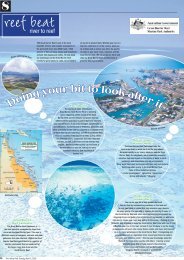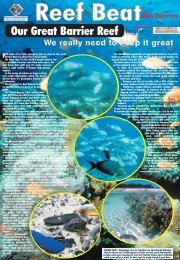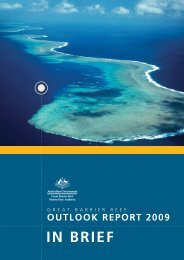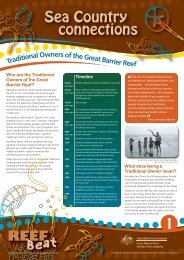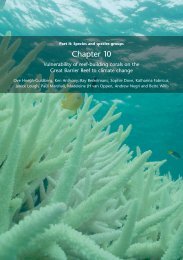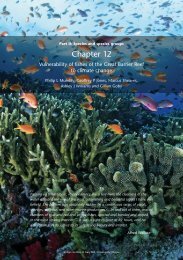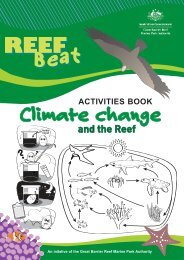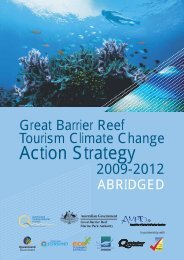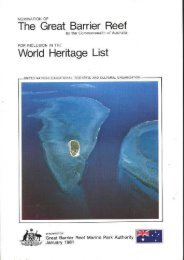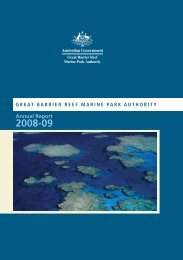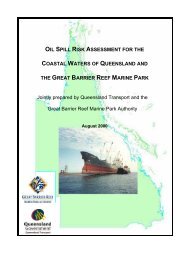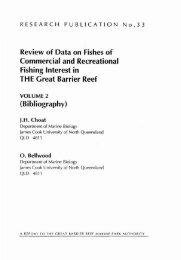Coral Bleaching Response Plan - Great Barrier Reef Marine Park ...
Coral Bleaching Response Plan - Great Barrier Reef Marine Park ...
Coral Bleaching Response Plan - Great Barrier Reef Marine Park ...
You also want an ePaper? Increase the reach of your titles
YUMPU automatically turns print PDFs into web optimized ePapers that Google loves.
<strong>Great</strong> <strong>Barrier</strong> <strong>Reef</strong> <strong>Coral</strong> <strong>Bleaching</strong> <strong>Response</strong> <strong>Plan</strong> 2005/2006<br />
the sites they visit during summer. The number of participants and geographic coverage of<br />
BleachWatch has continued to grow, with currently 87 participants.<br />
BleachWatch participants are provided with a BleachWatch kit and asked to complete purpose-designed<br />
monitoring forms on a weekly basis. Participants are asked to provide general observer information<br />
(section 1), as well as details about their site, type of habitat and specific weather conditions (section 2)<br />
that are known to influence risk of bleaching (i.e. water temperature, cloud cover, air temperature, wind<br />
speed). Detailed information about reef condition (section 3) and bleaching observations is also<br />
collected (a copy of the form is at Appendix A). Once the observer has submitted the first site report to<br />
the GBRMPA, they need only fill out sections 1 and 2 and tick ‘no change’ unless coral bleaching is<br />
observed or there has been a change in conditions at the reef site. It is estimated that completion of the<br />
form takes approximately 10 minutes per week for each participant. The data submitted by<br />
BleachWatch observers will be compiled and synthesised into summary reports during the summer<br />
season, these will be sent to participants for their information and for display to their clientele on board<br />
tourism vessels. The data collected is reviewed weekly to identify where coral bleaching has been<br />
sighted, whether it is spatially or locally significant and whether the Assessment and Monitoring<br />
component of the <strong>Response</strong> <strong>Plan</strong> should be implemented.<br />
Less regular or one off reef visitors can also submit observations on reef status and coral bleaching to a<br />
central database on the GBRMPA website. Reports will be compiled onto maps every 1-2 months<br />
during the summer season, and published on the website.<br />
Objectives: • To detect the early stages of coral bleaching events over a wide geographic area<br />
• To involve the community in reef monitoring, reef education and reef<br />
conservation relating to coral bleaching and climate change<br />
Strategies: • Develop and maintain a network of regular reef users who will provide reports of<br />
coral bleaching conditions at reefs that they regularly visit<br />
• Provide operators with a BleachWatch kit that assists them in reporting on reef<br />
conditions and detecting coral bleaching. The BleachWatch kit includes:<br />
- Interpretive material on coral bleaching and climate change<br />
- Examples of coral growth forms<br />
- Examples of bleaching severity<br />
- Monitoring forms<br />
- Instruction for the monitoring form<br />
- In-water identification wrist band<br />
• Regularly enter and evaluate data received to determine the composition of each<br />
reef to assist with evaluations of bleaching susceptibility<br />
• Provide regular feedback in the form of summary site reports and to all<br />
participants<br />
• Develop and maintain a website providing information on BleachWatch,<br />
including a downloadable version of the datasheet, on-line reporting form and<br />
copies of the site reports for each participant<br />
• Provide regular feedback in the form of reports, web updates and informal<br />
communications, to all participants<br />
Triggers: Reports of spatially extensive or severe local bleaching will trigger the <strong>Bleaching</strong><br />
Assessment and Monitoring component.<br />
2.4 BleachWatch (Aerial)<br />
BleachWatch (Aerial) is the product of broad-scale aerial surveys conducted in previous years.<br />
BleachWatch (Aerial) is a partnership between GBRMPA and Coastwatch and benefits from the active<br />
involvement of Coastwatch pilots and crew who visit an extensive number of reef sites regularly<br />
throughout summer. Pilots and crew are trained in identifying possible bleaching from the air and asked<br />
to take geo-referenced photographs for later analysis. The information collected by BleachWatch<br />
Climate Change <strong>Response</strong> Programme - GBRMPA 5



